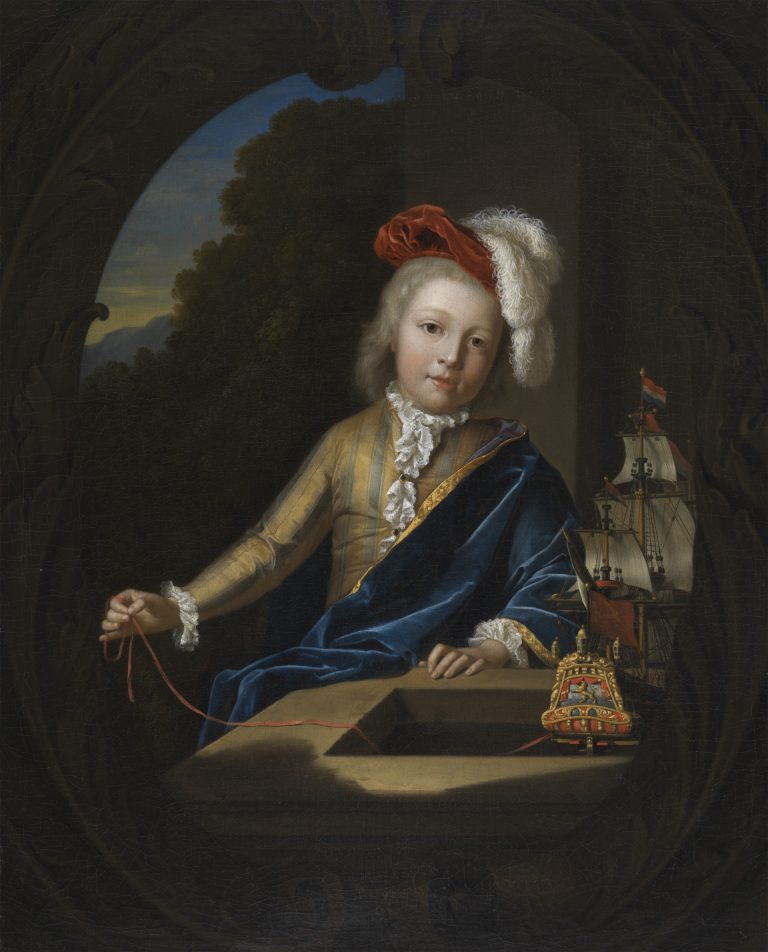Looking at us from his place in a decorative oval frame of palm branches painted to imitate a relief in stone, a blond-haired boy, whose sumptuous clothing includes a red velvet beret with three white feathers, is seen against a parklike background. He wears a yellow-and-gray striped suit over a shirt with lace cuffs and collar. A blue shawl trimmed with gold braid is draped over his left shoulder. Floating in the rectangular stone basin next to him is a small three-master with a reddish orange ribbon tied to it, which he holds in his right hand. As far as is known, this portrait of a boy playing with a miniature three-master is unique in Dutch painting of the seventeenth century. The miniature three-master flies the red, white and blue flag of the Republic of the Seven United Netherlands atop the mainmast and the mizzen, and a golden lion rampant adorns the taffrail (taffarel), the part of a ship that rises above the stern and is often decorated with ornate woodcarving. An arm holding a raised sword is discernible on the orange flag flying above the taffrail.
The canvas was signed and dated 1696 by Pieter van der Werff. This date is significant in the artist’s oeuvre, because in that year he embarked on the most important commission of his career: 30 oval portraits of the directors of the Rotterdam Chamber of the Dutch East India Company (VOC) and their illustrious predecessors, going all the way back to the chamber’s founding in 1602.1 The series, intended as a gallery of honor, was meant to hang in the trade hall of the new Oost-Indisch Huis, located on the Boompjes. The cornerstone was laid in 1695 and the building was finished in 1698. Pieter van der Werff painted the first portraits from existing works—including originals by Frans Hals (1582/83–1666), Ludolf de Jongh (1616–79), and Pieter’s elder brother, Adriaen van der Werff (1659–1722)—which is why he did not sign them. He did, however, sign the portraits in this series he painted from life after 1698.
Thanks to this commission, from 1696 onward Pieter van der Werff regularly found himself in the company of the most prominent families of Rotterdam, searching for portraits of deceased directors of the VOC that he could use as examples. The boy portrayed here must therefore belong to a family with VOC connections, as evidenced by both the portrait’s date and the sitter’s toy ship. The three-master can in fact be identified as an East Indiaman. Ships of this type, which averaged 40 meters in length, were generally used by the VOC for trade with Asia.
In addition to obvious connections with the VOC, the boy’s family probably also had ties to the Admiralty on the Maze (Meuse), which would not have been unusual in Rotterdam. This link is suggested by the golden lion on the stern. The most famous ship with the name and taffrail decoration of Gouden Leeuw (Golden Lion) was the over 50-meter long, 82-gun three-master built in 1666 by the Amsterdam Admiralty. It became the flagship of Admiral Cornelis Tromp, the Rotterdam-born son of Admiral Maarten Harpertsz Tromp. The Gouden Leeuw was one of the most famous Dutch men-of-war of its time, alongside De Zeven Provinciën (The Seven Provinces), the flagship of Admiral Michiel de Ruyter. Willem van de Velde the Elder (1611–93), his son Willem van de Velde the Younger (1633–1707), and Ludolf Bakhuizen (1631–1708) portrayed the Gouden Leeuw on several occasions, even after the vessel was retired from service in 1686.2 In contrast to the Rotterdam Chamber of the VOC, which played a less influential role within the organization, the Admiralty on the Maze was second in importance in Holland only to the Amsterdam Admiralty. The Maze Admiralty was in fact the oldest and most venerable admiralty college in the Dutch Republic. Serving as a representative of this admiralty was a great honor, certainly in Rotterdam. We may therefore assume that Pieter van der Werff deliberately portrayed this boy with a toy three-master that refers to the legendary Gouden Leeuw.3
